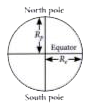Keeping the mass of the earth constant, if the radius of the earth decreases by 2%. What would be the change in .g.?
We know that the relation between .g. and .G. is g= GMR2
When mass is kept as constant and radius is decreased by 2% thenΔRR×100=2
From distribution of errors in multiplications and divisions Δgg×100=−2ΔRR×100
% change in g=−2×2=−4% -ve sign indicates that when R decreases .g. increases.
Topper's Solved these Questions
- GRAVITATIONBOOK - AAKASH SERIESCHAPTER - GRAVITATIONEXERCISE - NUMERICAL EXERCISE (LEVEL - 1)
19 Videos
- GRAVITATIONBOOK - AAKASH SERIESCHAPTER - GRAVITATIONEXERCISE - NUMERICAL EXERCISE (LEVEL - 2)
8 Videos
- GRAVITATIONBOOK - AAKASH SERIESCHAPTER - GRAVITATIONEXERCISE - Practice Exercise
56 Videos
- GAUSS.S LAW BOOK - AAKASH SERIESCHAPTER - GAUSS.S LAW EXERCISE - PROBLEMS (LEVEL - II)
12 Videos
- GRAVITATIONALBOOK - AAKASH SERIESCHAPTER - GRAVITATIONALEXERCISE - EXERCISE -3
154 Videos
Similar Questions
Knowledge Check
The Earth is not a perfect sphere. Due to the flattening of Earth at the poles, the radius of Earth is minimum at the poles and hence the value of g is maximum at the poles. One the other hand, the radius of the Earth is maximum at the equator of the Earth. As the mass and radius of moon are smaller than that of the Earth, so the value of g on moon is 1.63m/s2 . As we go up from the surface of the Earth, the distance from the centre of the Earth increases and hence the value of g decreases. The value of g decreases as we go down inside the Earth and it become zero at the centre of the Earth .

If the radius of the Earth were to shrink by 1% and its mass remaining the same, the acceleration due to gravity on the Earth's surface wouldAdecreasesBincreasesCremain unchangedDwill decrease by 9.8%If both the mass and radius of the earth, each decreases by 50%, the acceleration due to gravity would
Aremain sameBdecrease by 50%Cdecrease by 100%Dincrease by 100%If both the mass and radius of the earth, each decreases by 50%, the acceleration due to gravity would
Aremains sameBdecreases by 50%Cdecreases by 100%Dincreases by 100%
Keeping mass unchanged if radius of the earth increases by a factor 4, then by which factor density must have to be changed so that the value of g remains same ?
View SolutionFind the percentage change in acceleration due to gravity on the surface of earth if the radius of the earth shrinks by 1.0%, mass remaining constant.
View SolutionThe Earth is not a perfect sphere. Due to the flattening of Earth at the poles, the radius of Earth is minimum at the poles and hence the value of g is maximum at the poles. One the other hand, the radius of the Earth is maximum at the equator of the Earth. As the mass and radius of moon are smaller than that of the Earth, so the value of g on moon is 1.63m/s2 . As we go up from the surface of the Earth, the distance from the centre of the Earth increases and hence the value of g decreases. The value of g decreases as we go down inside the Earth and it become zero at the centre of the Earth .

What will be the unit of Gg ?
View SolutionAcceleration due to gravity on the surface of the earth is g=GMR2. The gravitational constant G is exacity known. But percentage error in measurement of the mass of earth M and radius of the earth R are 1% and 2%, respectively. The maximum percentage error in measurement of acceleration due to gravity on the surface of the earth is
View SolutionIf the radius of the earth decreases by 20% such that mass does not change, then the length of the new day would be
View Solution
